Use this in-depth tutorial to learn how to make a from-scratch puff pastry dough variation. The homemade dough comes together using a “rough puff” method where you carefully work butter into your dry ingredients and then fold and flatten the dough many times to create countless flaky layers. Unlike the breakfast pastries dough, this dough does not require any yeast and unlike croissants and traditional puff pastry, this dough does not require laminating with a layer of butter. Rather, the layers and crisp flakiness come from the particular mixing and folding methods.
One reader, Aimee, commented: “I have always wanted to try puff pastry. I always felt it was so ‘daunting.’ This recipe was so easy and my first ever puff pastry came out FANTASTIC! I do come to this site for new ideas. Thank you so much! ★★★★★“
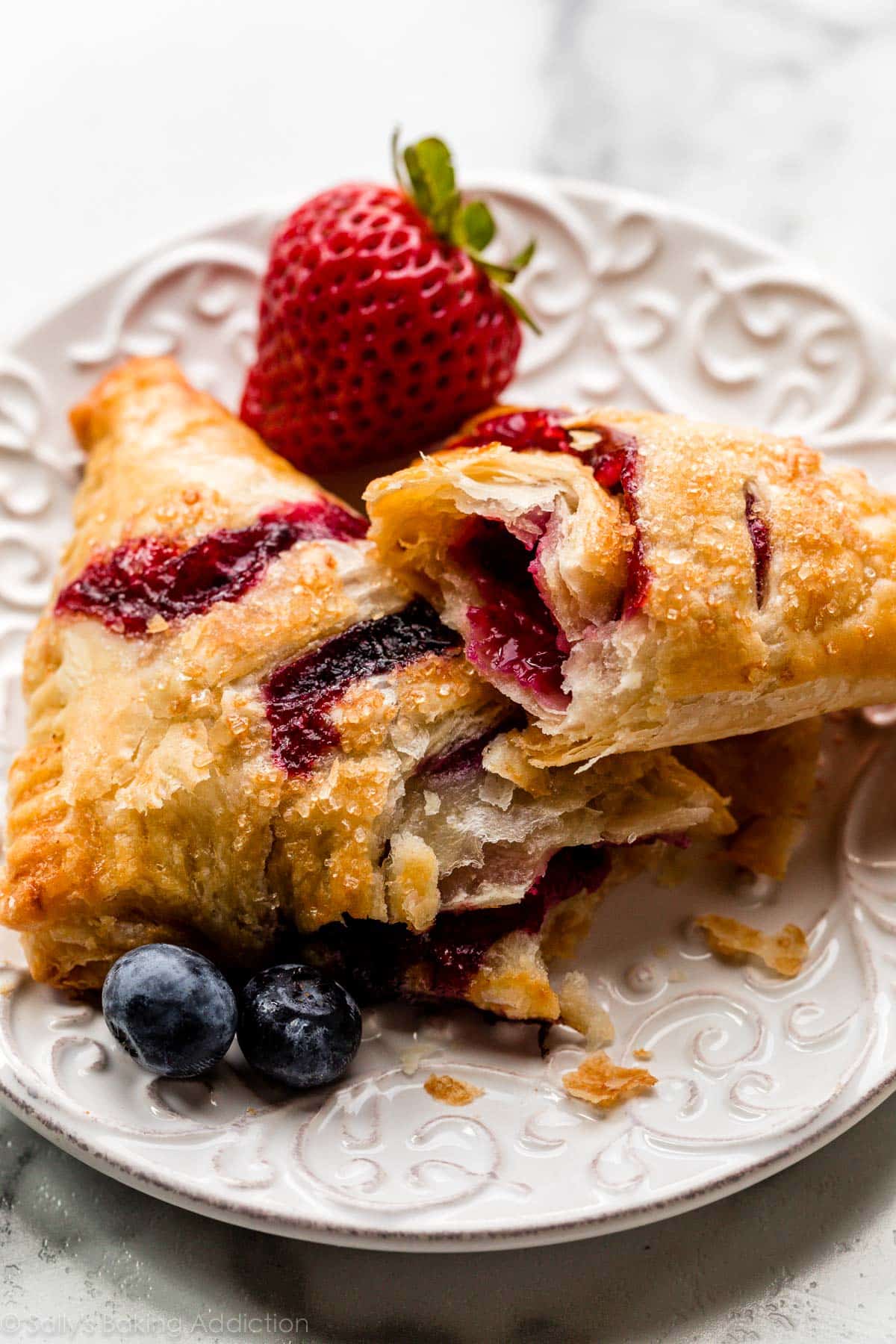
Using this simplified method and a handful of basic ingredients, you’ll be amazed that you can make puff pastry from scratch within just a few hours. Whenever I make and bake this dough, I’m still stunned with the outcome! You’ll enjoy using this dough wherever you use a single pie crust or store-bought puff pastry.
This recipe is such a fan favorite, that it deserved a spot in print! You’ll also find this recipe in my cookbook, Sally’s Baking 101.
Next you’ll find some details, step-by-step photos, plus there’s a video tutorial in the recipe if that’s helpful too. All of this will help set you up for success when it’s your turn to try it!
What Is Rough Puff Pastry?
Rough puff pastry is also known as quick pastry and become really popular with professionals and home bakers because you get bakery-style puff pastry without precise shaping and laminating butter with dough. Cookbook author and chef Claire Saffitz has a wonderful recipe for it. The trick is to work large pieces of cold butter into dry ingredients and hydrate it all with ice cold water (as if you were making pie crust). Sometimes bakers grate butter into the mix or use a food processor. There’s lots of ways to make rough puff pastry.
With this recipe, I stick with cold cubes of butter and use my hands to rub the butter into the flour mixture. Your hands are your best tool and method here because it’s nearly impossible to over-mix the dough this way. If the dough is over-mixed and you break down the butter too much, you’ll lose layers.
- Can I use a food processor, pastry cutter, or other mixer? I do not recommend it. These tools slice down the butter too much and you’ll lose a lot of flaky layers. I tried and it’s not worth it because the result is closer to a greasy pie dough than a layered puff pastry. (Still good, but not the goal here.)

Rough Puff Pastry Details
- Taste: Buttery, hardly sweetened, a little salty.
- Texture: Ahh, the best part. Each bite has oodles of crispy, crackly layers of light and buttery pastry. This pastry is one of the FLAKIEST doughs I’ve ever worked with and comes close to croissants territory. (But made in a fraction of the time!)
- Ease: I categorize this as an intermediate baking recipe. While it’s not nearly as involved as homemade croissants or homemade cruffins, it’s certainly not as easy as using store-bought frozen puff pastry. You need to flatten and fold the dough 6x, but there’s no chilling between each time so the recipe moves quicker than traditional homemade puff pastry.
- Time: The dough requires 2 separate refrigeration steps, but the 2nd one is only 15 minutes. You can easily make this dough in a few hours or over the course of 2 days. I always appreciate make-ahead dough where you have plenty of options in terms of timing. You can also freeze the dough, too.
How Is This Different From Pie Crust and Yeasted Pastry Dough?
Pie crust, while buttery and flaky, is not nearly as light, doughy, and crisp as this shortcut puff pastry. Yeasted pastry dough, such as something we can use for croissants, croissant bread, or a blueberry cream cheese pastry braid, contain yeast. This recipe simply relies on big chunks of cold butter (lots of it) and folding.
Just 5 Ingredients in the Rough Puff Dough
This shortcut pastry dough comes together with flour, sugar, salt, cold butter, and cold water.
- Why do the butter and water have to be cold? It’s important for the butter to stay cold so it doesn’t melt and soak up all the flour. We want the butter to stay solidified as we roll, shape, fold, and flatten this dough because if it melts before baking, you lose all the flakes. Game over. You see, when the butter melts in the oven, it creates steam and that steam separates the dough into multiple flaky layers. Cold butter is what makes cheddar biscuits and scones flakey too!
Rolling & Folding
Step by step photos of this process are below the recipe.
After you prepare the dough and chill it in the refrigerator for at least 2 hours (1st refrigeration), you will begin rolling it out with a rolling pin and folding it like a business letter, rolling it out again, folding again, and so on. You will roll + fold it a total of 6 times before refrigerating again for at least 15 minutes (2nd refrigeration).
The photo below shows what the center of your dough looks like after all the rolling and folding. *Note that I sliced a sliver off the end so I could show you this!


Uses for This Rough Puff Dough
After the 2nd refrigeration, you can use this dough for:
- Honey Pear Tart
- Cinnamon Spice Palmiers
- Any recipe calling for 1 box (1 pound; 2 sheets) store-bought puff pastry
- Berry Turnovers (pictured above and below)
- Cranberry Brie Puff Pastry Tarts
- Caramel Apple Turnovers
- Butternut Squash & Mushroom Tart
- Mushroom Puff Pastry Tarts
- Mille-feuille
To use as pie crust: You can use this pastry dough as pie crust in a recipe that calls for a single crust 9-inch pie. Roll dough out into a 12-inch circle before fitting into your 9-inch pie. Though all pie recipes are different, it would definitely be best to blind bake this dough with pie weights before adding a filling. Choose pie recipes that already call for blind baking and have a thicker filling. This would be excellent as the crust for quiche.
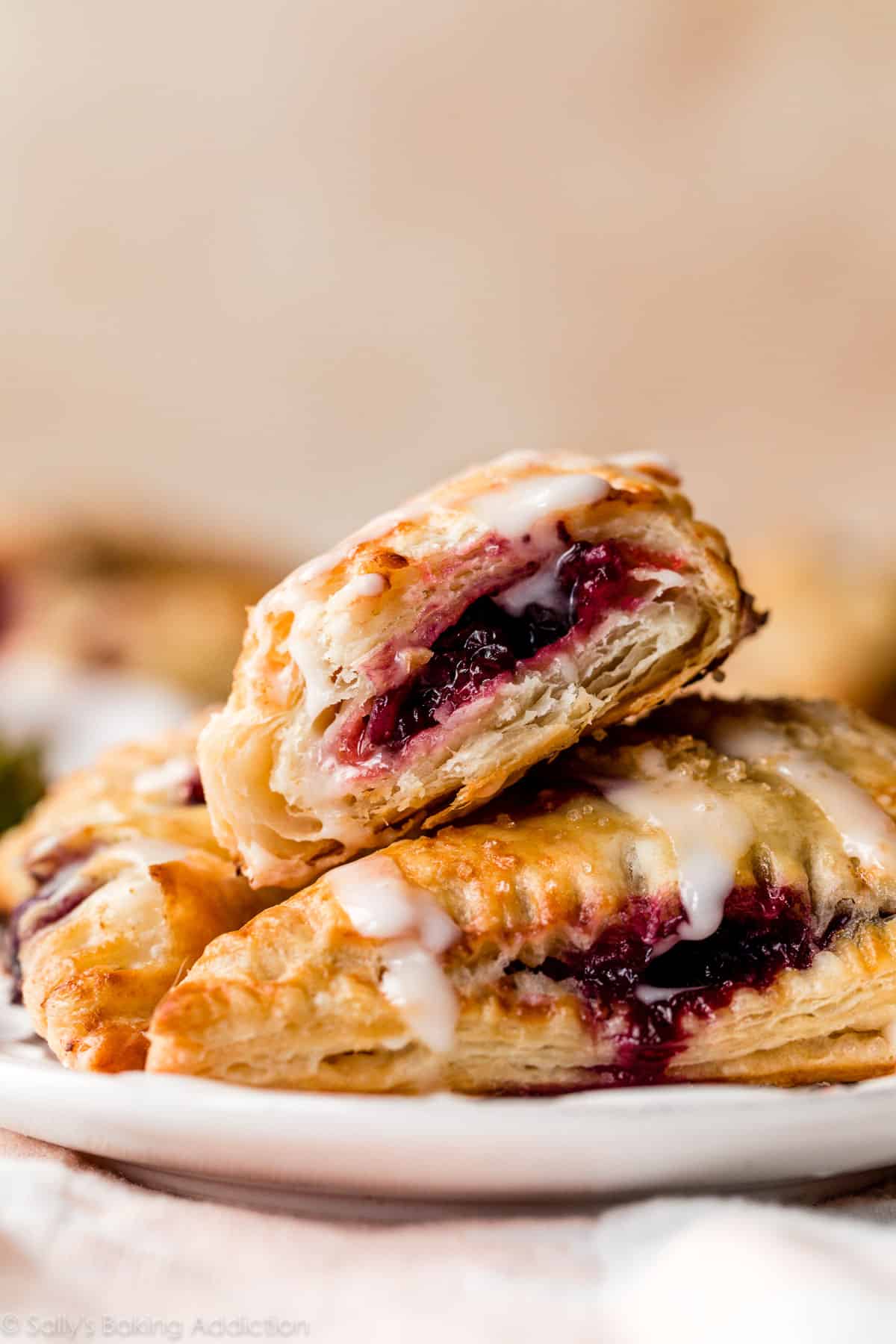
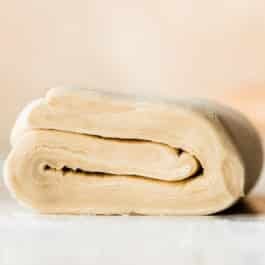
Handmade Puff Pastry (Rough Puff Method)
- Prep Time: 3 hours
- Cook Time: 0 minutes
- Total Time: 3 hours
- Yield: about 1 lb. (454g) dough
- Category: Baking
- Method: Folding
- Cuisine: American
Description
Use this in-depth tutorial to learn how to make a from-scratch puff pastry dough variation. The homemade dough comes together using a “rough puff” method where you carefully work butter into your dry ingredients and then fold and flatten the dough many times to create countless flaky layers. Make sure you start with very cold butter. This recipe is also in my cookbook, Sally’s Baking 101.
Ingredients
- 1 and 1/3 cups (167g) all-purpose flour (spooned & leveled), plus more as needed
- 1 teaspoon granulated sugar
- 1/2 teaspoon salt
- 3/4 cup (12 Tbsp; 170g) unsalted butter, very cold and cubed
- 6–8 Tablespoons (90–120g/ml) ice-cold water
Instructions
- Make the dough: In a large bowl, whisk the flour, sugar, and salt together. Place the cold and cubed butter on top. Gently toss the flour and butter together with your hands, and then briefly rub the butter into the flour to begin combining them, as you can see in the video tutorial. You do not want to break down the butter too much in this step. I do not recommend a food processor, pastry cutter, or mixer for this step because it will break down the butter too much.
- At this point, the butter is still in large cubes/chunks. Begin adding the ice-cold water, 1 Tablespoon (15g/ml) at a time, using your hands to toss the mixture together after each addition. (I usually start with 2 Tablespoons of water before I begin tossing together.) You can use a spatula or spoon for tossing, but I really do recommend your hands so you get a good feel of the dough. As the dough begins to hydrate after about 4 Tablespoons of water, you can start lightly squeezing or clumping the dough together with your hands to help bring it together. Mixture will still be very shaggy, as you can see in the video and photos. If your dough feels sticky and wet before adding 6 Tablespoons of water, mix in 1 Tablespoon of flour (your butter was likely too warm—you can continue with the recipe, but the dough may not be as flaky).
- Pour the shaggy clump of dough out onto a lightly floured work surface. There should still be large chunks of butter at this point. With lightly floured hands, begin patting the dough down until it’s 3/4–1 inch thick, about a 5×8-inch rectangle. Fold the dough into thirds as if you were folding a business letter. Use your hands to gently flatten and smooth out any cracks in your dough. Wrap it tightly in plastic wrap or parchment paper, or place into an airtight container.
- 1st refrigeration: Refrigerate the dough for at least 2 hours and up to 24 hours.
- Roll & Fold: Take the dough out of the refrigerator to begin the “rolling and folding” process. If the dough chilled for longer than about 3 hours, it’s likely very stiff, so let it rest for about 5 minutes before you begin rolling. Lightly flour a work surface. The dough gets sticky, so make sure you have more flour nearby as you roll and fold. Using lightly floured hands, gently flatten the dough into a small square. Using a rolling pin, roll the dough into a rectangle that’s 1/2 inch thick, about 6×12 inches. The exact dimensions are not important, but the thickness is. As you roll, it’s best to flip the dough over once or twice to make sure it’s not sticking to your work surface. Lightly flour your work surface as needed. Fold the rectangle into thirds as if it were a business letter. (See photos and video tutorial.) Turn it 90 degrees and roll it out into a 1/2-inch-thick rectangle again. Fold into thirds again. Turn it 90 degrees. You’ll repeat rolling and folding 4 more times for a total of 6 times.
- 2nd Refrigeration: Wrap the dough tightly and refrigerate for at least 15 minutes and up to 24 hours before using in your recipe. You can also freeze the dough at this point. See Notes.
- Use wherever you would use frozen store-bought puff pastry. To bake plain, roll pastry dough into a 10×16-inch rectangle and place on a lined baking sheet. Brush all over with egg wash (1 large egg whisked with 1 Tbsp milk), and bake at 400°F (204°C) until golden brown and puffy, about 25–28 minutes.
Notes
- Make Ahead & Freezing Instructions: Prepare as instructed in steps 1–3. At this point the dough can be refrigerated up to 24 hours (see step 4). You can also prepare the dough through step 5. At this point the dough can be refrigerated for up to another 24 hours (see step 6). During or after this second chilling time, you could also freeze the dough for up to 1 month. (I don’t recommend freezing the dough before the rolling and folding step.) Thaw overnight in the refrigerator before using in a recipe that calls for 1 lb. puff pastry dough (or 1 store-bought package with 2 sheets puff pastry).
Step-by-Step Photos
The following photos show the bowl of dry ingredients with the cold and cubed butter on top. In the right photo, you can see me gently tossing the flour and butter together. In this step, I’m briefly/barely rubbing the butter into the flour to start combining them. This step is only possible if the butter is very cold because if the butter is warm, you’ll end up with paste.
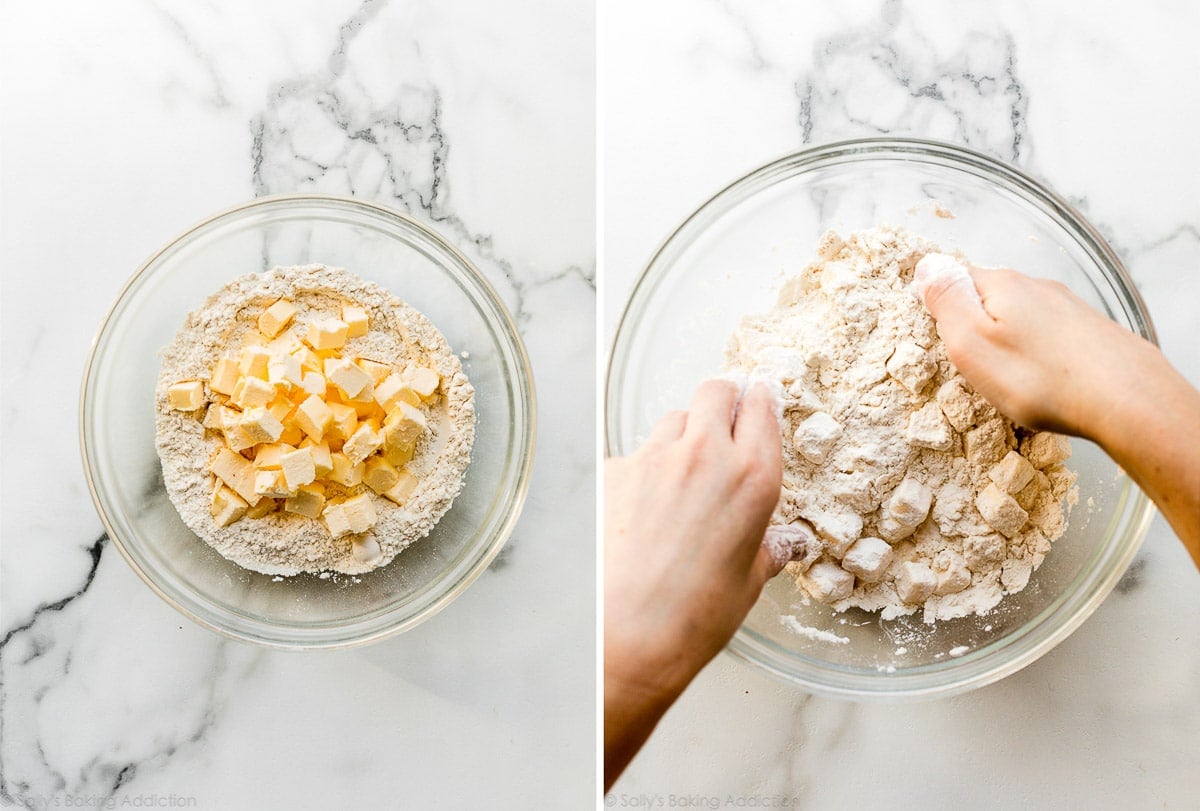
At this point, as you can see in the photo on the left below, the butter is still in large cubes/chunks. That’s great! Now let’s add the ice-cold water 1 Tablespoon at a time, using our hands to toss it all together. (Note that I usually start with 2 Tablespoons of water before I begin tossing together.) You can use a spatula or spoon for tossing, but I really do recommend your hands so you get a good feel of the dough.
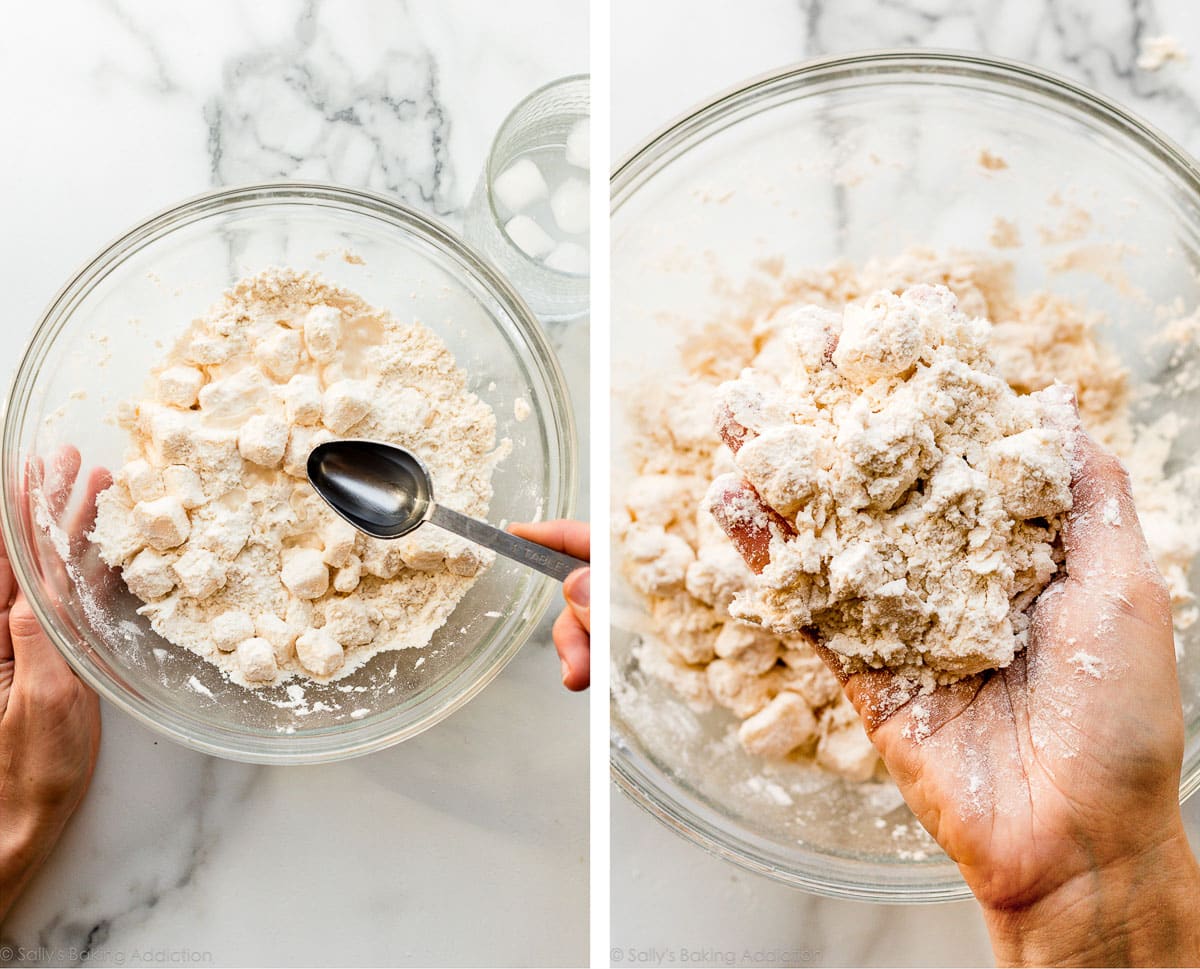
Photo below left: Continue adding the ice cold water and tossing the mixture together after each has been added. As the dough begins to hydrate after about 4 Tablespoons of water, you can start lightly squeezing or clumping the dough together with your hands to help bring it together. Mixture will still be very shaggy, as you can see.
See the photo below on the right? You only need 6–8 Tablespoons of ice-cold water to get to this point. Do not add any more or any less. If your dough reaches this point before adding 6 Tablespoons of water, your butter was likely too warm. You can continue with the recipe with less water, but the dough will not be as flaky.
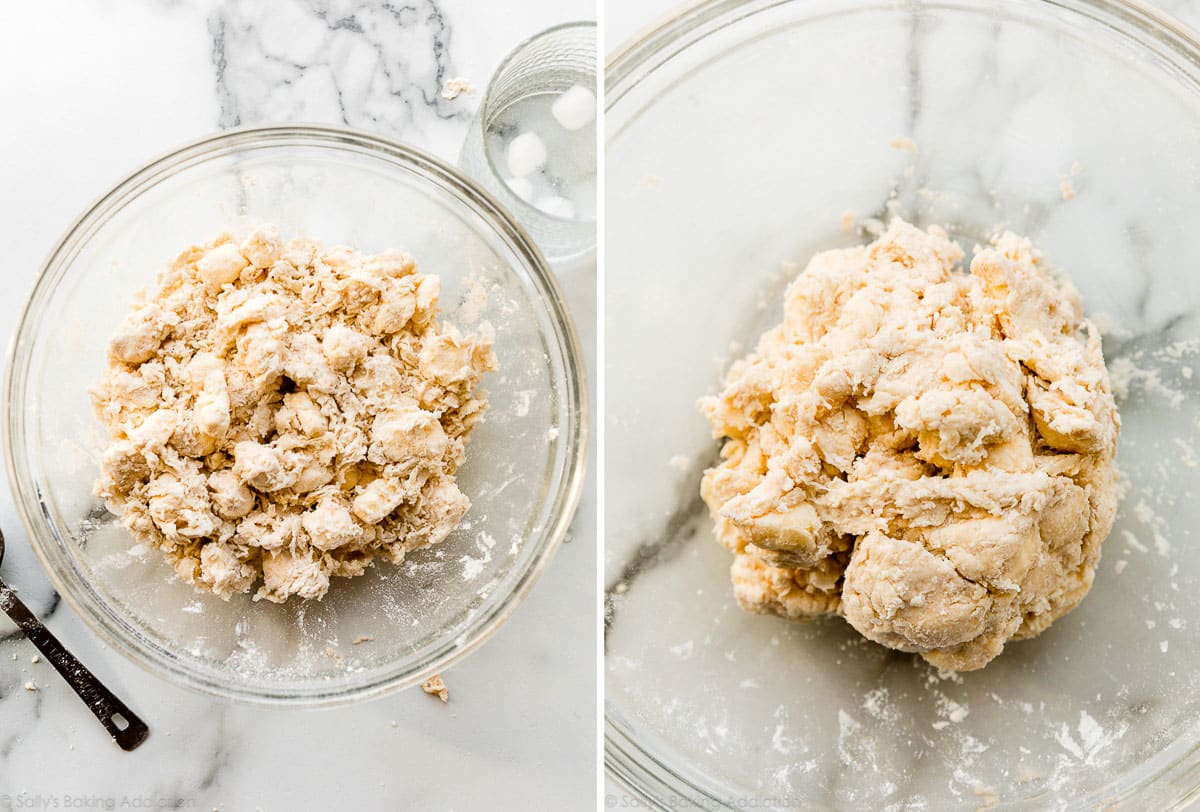
Pour the shaggy clump of dough out onto a lightly floured work surface, as you can see in the photo on the left below. There will still be large chunks of butter. Begin patting it down with your hands until it’s about 3/4–1 inch thick, about a 5×8-inch rectangle:

As shown in the photos below, fold the dough into thirds as if you were folding a business letter. This is exactly how we fold biscuits dough, too!

1st refrigeration: Now use your hands to gently flatten and smooth out any cracks in your dough “business letter” then wrap it in plastic wrap, aluminum foil, parchment paper, or place in a sealed container, and refrigerate for at least 2 hours and up to 24 hours.
Now it’s time for the rolling pin. Remove dough from the refrigerator and begin rolling out.

You’re going for a thickness of 1/2 inch, so the rectangle should be about 6 x 12 inches. The exact dimensions are not important, but the thickness is. Fold the rectangle into thirds like a business letter:

Turn it 90 degrees, then grab your rolling pin again:

Repeat this 5 more times, for a total of 6 rolling out + folding sessions.
Success Tip: If the dough “business letter” is so thick or impossible to roll out, cover it with a clean kitchen towel and let it rest for 5 minutes before trying again. The butter just needs to slightly soften. Lightly flour your work surface whenever necessary.
After the 6th time, you may not be able to see visible chunks of butter anymore. (If you do, that’s fine. If you don’t, that’s also fine.)
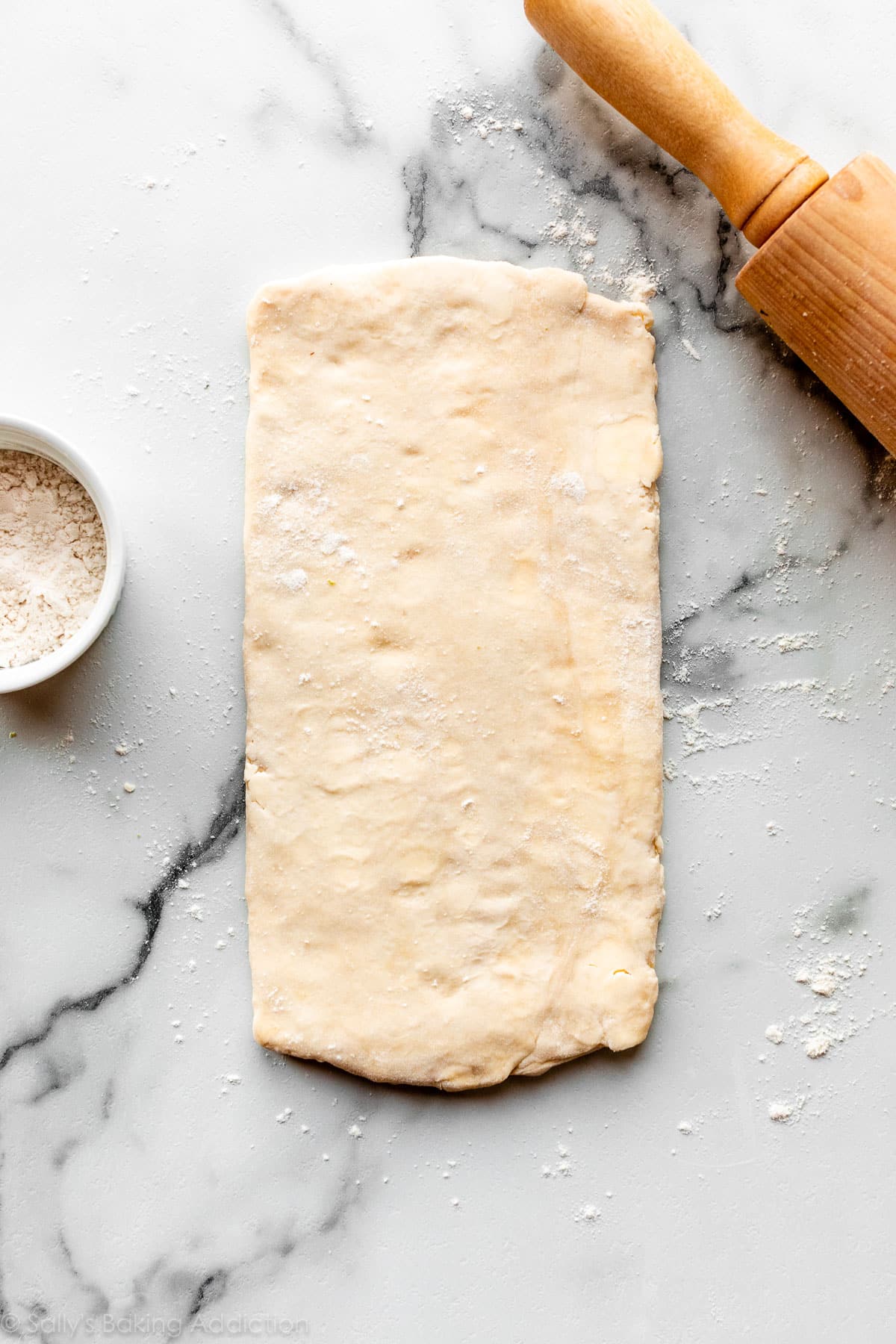
2nd refrigeration: Fold the dough into a business letter, wrap tightly, and then chill for at least 15 minutes and up to 24 hours. Now you can use it in your recipe such as homemade palmiers or this butternut squash and mushroom tart.







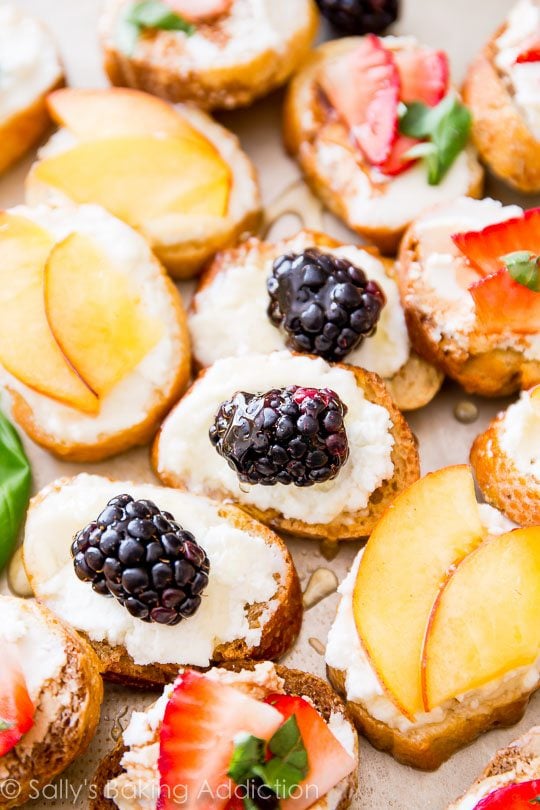











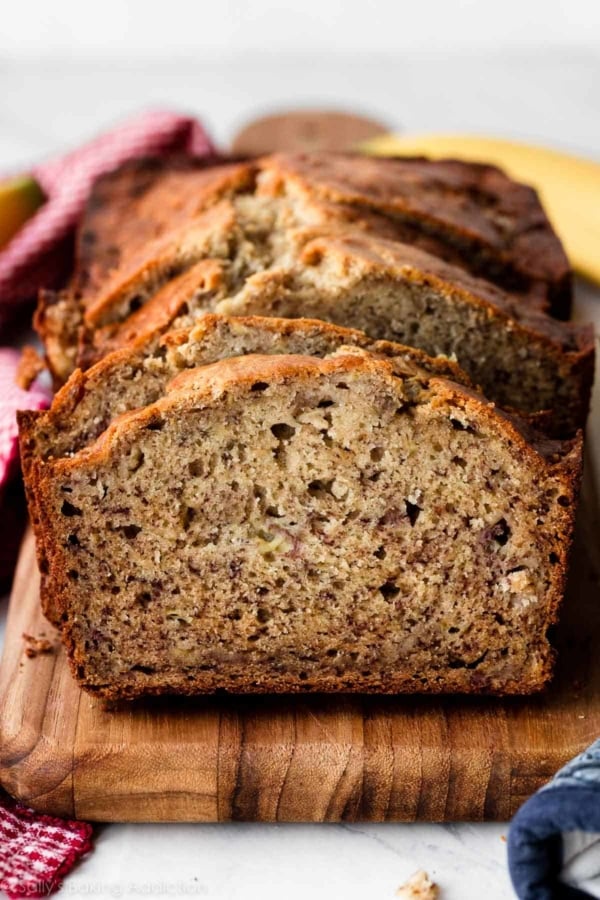

Reader Comments and Reviews
I’m trying to bake for someone with Alpha Gal Syndrome, which means no butter. Has anyone tried making this recipe with “plant butter” sticks? (For those who don’t know, Alpha Gal is a potentially life-threatening food allergy, so please–I already know butter would give a superior taste, but alas, it’s off the table–literally.)
Hi Joy, we haven’t tested this recipe with a plant based butter to know how it might impact results. Hopefully someone else can weigh in if they’ve been successful with this swap. Let us know if you do any experimenting!
love your recipes and explanations
Amazing recipe I have used it so many times!
I was recently asked to make cheese sticks for a family gathering, would this work as a base recipe for cheese and herbs?
And if so how much do you think it would make?
Hi! So happy you’ve been enjoying this dough. Yes, you can definitely use the rough puff as a base for cheese sticks; I’m sure it would work wonderfully with shredded cheese and herbs folded or sprinkled in. The yield will depend a bit on how thin you roll the dough and how wide you cut the strips. Let me know how they turn out!
I love this recipe. The first time it seemed dry and needed extra water. Since then I weigh the flour and I can rely on it to work every time.
I used to buy Pepperidge Farm, until I read the ingredients: Enriched flour, palm, soybean, and hydrogenated cottonseed oils, high fructose corn syrup, salt, mono and diglycerides, soy lecithin, malted barley flour, and turmeric and annatto extracts. NO butter! HFC syrup?
With this recipe, there is no excuse (for me) to not make it from scratch.
I love this recipe. (I love all your recipes, but this and your *flawless* chocolate cake in particular are in regular rotation)
This one is so much easier than I ever expected, and so versatile. I made breakfast sausage rolls, and of course pie crust, and flaky pastries, but my favorite way to use this is cut in squares and tucked into a mini muffin tin, topped with brie and either cranberries or fig jam…
I highly recommend this for beginners who aren’t confident they can do something delicate and flaky. It’s so easy, just follow the directions carefully and keep it cold and it comes out perfect every time!
We’re so thrilled to read this, Rosie!
Hello! I was so excited to try your rough puff pastry after watching way too many GBBO. The first time it came out perfectly, very crisp and flaky for apple turnovers. I wanted to improve the apple filling results so I made them a second time. Sadly the pastry was not as good. Did the same exact steps as the first time. What do you think it was? My butter was extra cold and I rested the same amount of time. I did find the second time the dough did “fight” me a lot more starting in fold 4. What do you think might have happen?
Hi Elaine! I’m so glad the first batch turned out so well, and I’m sorry the second wasn’t as flaky. When the dough starts fighting back/not stretching, it usually means the gluten has tightened and the dough just needed a longer rest before continuing. Even an extra 10–15 minutes in or out of the refrigerator can make a big difference. Next time, if it starts resisting, just pause and let the dough rest before moving on.
Rough puff pastry, otherwise known as flaky pastry, is English in origin and we’ve been making it, and enjoying it for centuries.
Can I use this for a top & bottom for a chicken pot pie?
Hi Gen! Puff pastry works beautifully on top of a chicken pot pie, but pie dough is best for the bottom.
Thank you for the video but I just want to say the music is quite annoying and I’d really like someone to be talking rather than just listening to inane music.
Came here via You Tube from a Google search – never made this pastry before. Did not want all the rubbish that’s in ready rolled. Was really easy to follow, and with your video made the process really simple. I did wonder if all the butter would combine but, with patience, it did! Trust the process! Thank you for the recipe and the guidance!
Yeah, that first step looks pretty chunky, but you gotta *believe* and remember to trust that Sally wouldn’t lead you astray…
Can I freeze the pastry so that it’s easy to grab and cook?
Absolutely, see Notes after the recipe for freezing instructions!
Regarding the homemade rough puff pastry dough, can I use gluten free flower? My granddaughter has celiacs and we can’t even use flower if she’s in the kitchen much less feed it to her.
Hi Faye, we have not tested it so can’t be certain of the results. Let us know if you give it a try and which flour you use.
Only have salted butter. Can I use it. If so should I omit the salt in the recipe?
Hi Lisa, You can absolutely use salted butter instead. You don’t have have to reduce the salt in the pastry, but if you wanted to– you can reduce to 1/8 teaspoon.
When making a peach or apple tart should you precook the dough
Hi Carol! Usually you would not need to.
I used this recipe to make cheese and onion rolls. (- the sugar obviously) and I’m so pleased with how they turned out for my first ever attempt. The pastry is so light, crispy and flakey and buttery, a world apart from any shop bought pastry I’ve ever tried! Thank you for the brilliant recipe!
Thrilled to read this review, Alice!
i made a mushroom, onion, and goat cheese galette as well as an herbed yogurt, tomato and asiago galette with two of these rough puff sheets. my uncle was visiting me from france, where he trained as a pastry chef and worked as a baker. he gave me $50 because he was so impressed with my “pâte”!! this was my third time using this recipe with great success. always make sure the dough is cold, cold, cold!! i find chilling it for 20-30 mins after assembling whatever creation you’re putting in the oven yields consistent results.
Hi, what is the thickness that this dough should be rolled out to for it to be flaky and cooked through? I used it for a pot pie recipe but it was undercooked in some spots so want to ensure it’s not too thick next time!
Hi Aty, you can try rolling it a bit thinner, say, about 1/4-inch or slightly thicker, next time. Thanks for giving this recipe a try!
Could I use whole wheat flour for this recipe?
Hi Jasmine, you could try replacing a small portion of all purpose with whole wheat flour, but expect a more dry result. All purpose flour really is best when working with pastry.
Where is the tutorial video? I’ve rad through the whole page, scanned it 3 times, and used the ‘find on page’ to search ‘video’
You can find the video in the recipe card after the written instructions, AJ!
I am also having trouble viewing the video on the page. I cannot see any videos in the recipe card, but there is a large blank space where I imagine it would be. I am on Safari on an iPhone 16 ProMax. I have reloaded the page. Tried in Chrome as well with the same results.
Hi Denise, thank you so much for letting us know. We’re working on having this issue fixed. You can always search for our recipe tutorials on YouTube as well. Sorry the video isn’t loading on our website properly!
Oh my these came out great.
Stuffed with mayo/Dijon mixture, ham and Swiss cheese. Sprinkled sesame seeds over egg wash.
Hi Sally
Thank you for the recipe ,it was easy and came out perfectly. I will definitely try your other recipes.
By far..the easiest and best recipe for rough puff I have tried..no reason to look at any other recipe…I had some homemade Salted Caramel Sauce and Creme Fraiche on hand as well as some Honey Crisp Apples…put together a Tarte Tatin which was absolutely delicious..the pastry was so light, so flaky and so buttery…everything you could ever want a Puff Pastry…store bought..even high quality brands do not even come near this..Thank You!